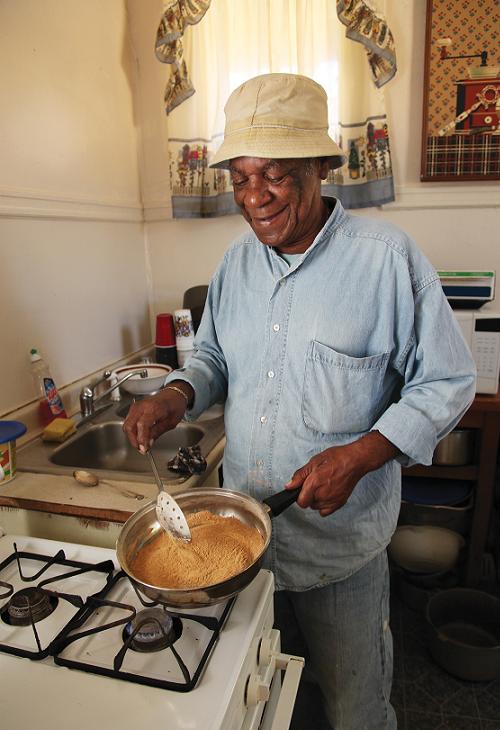“When I was a kid, I did never go outside. Always stayed inside, and my grandmother used to cook. I helped her cut up the seasoning. Then when my grandmother died, I liked to stay home and watch my mom cook. I just wasn’t interested in being outside. I don’t go nowhere now, you know, unless I’m going fishing. You won’t get any trouble, that’s for one thing. Just stay inside, watching cooking shows on TV.
In the fall, I mostly cook greens—cabbage, mustard greens, turnip greens; rabbit, raccoon, venison in season. A lot of fish because I go fishing a lot. We go down to Port Sulphur and Empire. The oil is not in the fish because if it was, you could tell when you’re cooking them, you’d smell it. I have a small 14-foot flat, enough to get me around where I need to be. I design for the second lines, the fans and the stuff in there. Prince of Wales has 12 adults and 6 kids, that’s what I’m working on now. So I can’t go fishing until after this. I can’t wait! When this is over with, that’s where you’re going to find me, sitting on some bayou.
I cook goat, the whole goat. Go get a goat up there in Boothville, up 90 going towards Houma. I soak him down in vinegar and a lot of seasonings—onion, garlic, bell pepper, celery—soak him down overnight. Put ice all over it, put the vinegar and the salt and the pepper, maybe a little cayenne, and the next day he ready. Put him on the grill. Sometime, I run him in the oven first, at 300, kind of get him going, you know, and then go put him on the grill. You’ve got to cut the veins out, the silk running through it; same with the venison. They make the meat tough. When you say goat, they’re coming, from everywhere. After you get it nice and tender on the grill, you put the sauce on there, start rubbing it down with the sauce,slapping it on there. I buy regular barbecue sauce. I used to make one, but my daughter used to help me to make it so I don’t make it no more, I just go buy me a sauce. I might add a little black pepper, a little honey, seasoning salt, lemon. Might put some oranges and squeeze in it. Put it on the ribs, come out real good. I might have goat, ribs, venison, coon, rabbit, squirrels. And there are hundreds of people out here, right out front my door. My mom used to do it when she was able; she used to feed everybody in the city.
For my roux, I just take a skillet, make it hot and pour the flour in there. That’s to keep the grease down. I don’t like all that grease. I don’t even like butter. Got some in there that’s been there a year or something. Doing the roux dry like this is easy, but if the phone rings, don’t go answer, I’m telling you. You have to stand there and stir it. That’s my cooking spoon over there, with the holes in it. I don’t know why, but that’s the one I like. I use this for everything.
Cooking is really easy, if you want to cook. I had to cook because I raised five kids by myself. I had to come home from work, cook for them, make sure they eat. And I knew how to cook. Now, I have seven grandchildren. The little girl, when I’m cleaning fish, she wants a knife, she wants to clean some fish, so I give her a butter knife, ‘Try this.’ I’ve got a lot of knives and they’re sharp. I love knives. I’ve got a lot more in the drawer right here. I buy knives for me everywhere. I do a lot of cleaning, a lot of different wildlife and fish and you’ve got to have a good knife, so I keep a lot of knives. All kind; I love knives. My friends say, ‘Why do you buy so many fishing poles?’ and I say, ‘They all do something different, that’s why.’ Same thing with knives.
Today, I’m making some filé gumbo with shrimp, crab, sausage, chicken and chicken gizzards—a lot of work for people who don’t like to cook. Like making an Indian suit, that’s a lot of work too. But, hey, not for the Indians. It’s easy, just take a little while.
I really like gumbo the next day. Everything is settled down and worked it’s way through, got together like a magnet, all join in on each other, that’s when it’s good to go.
A friend of mine, he goes up to the country and gets coons from the trappers. I always get five or six, because the people who follow me on Mardi Gras Day, they love it. The most important thing in cooking a raccoon is you have to musk him, you have to get the musks out. A large coon got 32 musks, and most of them come out when they pull the hide off, but you’ve got to make sure you get them all out. When I do that I put my glasses on. The meat is like a dark red and the musks are a little lighter than that, so you can see them. You just got to know what you’re looking for. After you musk him, wash him down real good, put him in a big pot and parboil him, because he’s real tough. Take a little seasoning salt, cayenne pepper, black pepper. Sometime I put liquid crab boil in there. Parboil him until you can flip the meat, breaks right loose. I do them whole because I like to barbecue the whole thing. Once you do that, you got him. Bring him to the grill, let him go. Some people don’t wait until you put the barbecue sauce on there. They’re going to eat it and love it. You know, I get a lot of this: ‘I don’t eat this, I don’t eat that,’ but when I go out there, the alligator, the coon and venison, all that’s gone. Somebody eat it.
Raccoon, that’s Mardi Gras evening. I generally get them for Christmas, but I hold them until Mardi Gras because I know they’ll get eaten up then. Then a friend of mine, he always comes from Detroit. I taught him how to musk them, so I don’t have to do that, I just continue sewing. He call me, ‘Come check it out!’ And I come check it out, put my glasses on. They’re like a football shape. I learned that when I was about 12-13 years old, how to musk them. One time I was selling papers, and I see this sign way down on Rampart Street, say ‘Coons.’ I said to myself I was going to buy one for mommy, and the guy in there asked me if I knew how to musk them and I said ‘No.’ He said, ‘Let me show you.’ Some of them are as big as a little fingernail. Once you take them out you can’t beat the taste. Coon, that was one of the first foods, you know, back in the day. Pioneers and all that. They had raccoon hats. What do you think they did with the meat? Threw it away?”
Baby Alligator Gravy
“If I use alligator fillets, I cut them up in little blocks, like bite-size pieces. Something you can put in your mouth, so you don’t have to stretch your mouth open. Cayenne is good for wildlife, all of it. It adds another notch to it, but my old lady can’t eat nothing spicy, so, mess my day up.”
2 pounds baby alligator legs, skinned (look like chicken drumettes)
2 tablespoons margarine
1 small onion, diced
4 green onions, chopped
1/4 bunch parsley, chopped
1/2 bell pepper, diced
1/2 jar Ragu Old World Style Traditional Pasta Sauce
1 teaspoon garlic powder
4 tablespoons dry roux
1 cup water
salt and black pepper to taste
cayenne to taste
Brown alligator in margarine in a large skillet. Set meat aside. Add onion, green onions, parsley and bell pepper to skillet and sauté until soft. Add Ragu, garlic powder and roux. Thin with water. Simmer for 30 minutes. Season to taste with salt, black pepper and cayenne. Add alligator back in and simmer, covered, for another 30 minutes.





